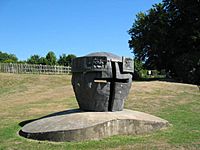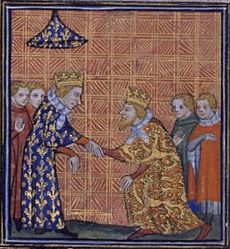Mise of Lewes facts for kids
| Settlement between King Henry III of England and oppositional magnates | |
|---|---|

1964 monument to the Battle of Lewes
|
|
| Type | Settlement |
| Signed | 14 May 1264 |
| Location | Lewes, Sussex |
| Effective | Immediately |
The Mise of Lewes was an agreement made on May 14, 1264. It was signed between King Henry III of England and a group of powerful nobles. These nobles were led by Simon de Montfort. This agreement happened on the same day as the Battle of Lewes. This battle was a major fight in the Second Barons' War.
The war started because many nobles were unhappy with King Henry. They felt he let too many foreigners have power. They also disliked his high taxes. In 1258, Henry had to agree to the Provisions of Oxford. This document gave a council of nobles control over the government. But the king often tried to cancel this agreement.
In 1263, England was close to a civil war. Both sides agreed to let the French king, Louis IX, decide. King Louis believed kings should have full power. So, he sided completely with Henry. The rebellious nobles could not accept this. War broke out very quickly after his decision.
The Mise of Lewes was signed after de Montfort won the Battle of Lewes. We don't know the exact details of the agreement. But it likely set rules for more talks. These talks were meant to find a lasting peace. However, a full peace was not reached. Support for de Montfort's government slowly faded.
Henry's oldest son, Edward, later King Edward I, started a new military campaign. This led to the Battle of Evesham in August 1265. De Montfort was defeated and killed there. Some rebel groups kept fighting for a while. But by the end of 1266, the last rebels at Kenilworth Castle gave up. The rebels were pardoned under new rules. These rules were called the Dictum of Kenilworth.
Why the War Started: The Background
By 1264, King Henry III's rule was full of problems. He had many disagreements with his nobles. Several things caused this conflict. One reason was the power of foreigners in the king's court. Another was a costly war over the crown of Sicily. There was also a personal fight between King Henry and Simon de Montfort.
In 1258, Henry was forced to accept the Provisions of Oxford. This meant he gave up control of the government to a council of nobles. In 1259, the nobles added more rules in the Provisions of Westminster. These rules stayed in place for three years.
It wasn't until 1261 that Henry could fight back. He got the Pope to cancel the Provisions. Then he took back control of the government. But over the next two years, people became unhappy again. Henry did not make peace with de Montfort. He also upset Gilbert, a powerful noble.
In April 1263, de Montfort came back to England from France. He restarted the reform movement. On July 16, Henry was surrounded by rebels in the Tower of London. He was forced to accept the Provisions again. Prince Edward, who later became King Edward I, then took charge. In October, Edward captured Windsor Castle. The nobles' alliance started to break apart.

De Montfort was in a difficult spot. He had to agree to a truce. He also agreed to let the French king, Louis IX, settle the dispute. This agreement was called the Mise of Amiens. King Louis decided completely in Henry's favor. He said the Provisions were not valid.
This decision did not solve the problem. Instead, it made things worse. The king's side won completely. This left de Montfort with no choice but to fight. The fighting began in February. De Montfort's sons, Henry and Simon the Younger, attacked lands belonging to Roger Mortimer.
Henry called his army. The king's forces won an important battle at Northampton. There, the younger Simon was captured. De Montfort still controlled London. Henry took back control of Kent and Sussex. De Montfort marched out of London to talk. But the king rejected his terms. These terms included keeping the Provisions.
The only choice left was to fight. The two armies met at Lewes on May 14, 1264. De Montfort's army had fewer soldiers. But they still won the battle. Edward, leading the right side of the king's army, quickly beat the London forces. But when he chased the fleeing soldiers, he left the rest of his army open to attack. De Montfort's forces used this chance. They soon won the day.
What the Agreement Said
We don't have the original document of the Mise of Lewes. So, historians have debated what it said. They also argue about when it was written.
A historian named Noël Denholm-Young suggested what the main points might have been in 1933. First, Prince Edward and his cousin, Henry of Almain, were to be given to the nobles as hostages. Second, nobles captured at Northampton were to be set free. Third, those who took royalist hostages at Lewes would get money for them. Finally, a group of French church leaders and nobles would help make a lasting peace. Many historians have agreed with this idea.
One point of debate was whether the Mise of Lewes mentioned the Provisions of Oxford. John Maddicott argued in 1983 that it must have. He said the Provisions were central to de Montfort's goals. So, he would not have given them up easily. However, de Montfort was willing to discuss the terms of the Provisions. This means the Mise of Lewes was a fair document. De Montfort wanted to avoid another situation like the Mise of Amiens. It was outside events that led to the failure of peace talks.
Another historian, David Carpenter, disagreed in 1985. He believed de Montfort did not want to compromise at all. Carpenter thought the Mise of Lewes was written during the battle. Not after it, as others thought. This meant de Montfort had to make deals to stop the fighting. Once the battle was over, and de Montfort was in charge, he no longer wanted to compromise. This is why the fighting continued. However, D. W. Burton later argued that the document was signed after the battle ended.
What Happened Next
De Montfort's new government soon faced many problems. He had little money. There was disorder across the country. And royalists exiled in France threatened to invade. Since the French peace committee failed, a temporary government was set up. It included de Montfort, the young Earl of Gloucester, and the Bishop of Chichester. These three would choose a council of nine. This council would rule until a lasting peace was found.
In August, the Peace of Canterbury forced Henry and Edward to accept even stricter terms. These were tougher than those in the Mise of Lewes. This new agreement said the current government would stay in power. It would rule through King Henry's reign and into Edward's.
To keep the borders safe, Montfort had to release Roger Mortimer and other royalist lords. These were powerful nobles from the Welsh borderlands. In December, de Montfort made Mortimer, Roger de Clifford, and Roger de Leybourne promise to leave England for Ireland. Then, in January, he called a parliament in Leicester. This became known as Montfort's Parliament. It included representatives from the shires and towns. This was a new idea in English government. Here, Montfort gained support for his rule.
But de Montfort's success did not last. A representative from the Pope rejected the Peace of Canterbury. This happened during talks in Boulogne. Meanwhile, the border lords did not leave England. They continued to cause trouble. The three leaders of the government split up. The Earl of Gloucester joined the royalist side.
In May, Edward escaped from being held captive. Gloucester helped him. Edward began a campaign to win back control. De Montfort had to stop a rebellion in the borderlands. He succeeded by making big deals with Llewelyn. Then he moved east to join his son Simon's forces. However, Edward defeated the younger Simon at Kenilworth Castle.
On August 4, 1265, de Montfort was trapped at Evesham. He had to fight with a much smaller army than the king's forces. The battle quickly became a terrible defeat. De Montfort himself was killed. Even with Montfort dead, some rebels kept fighting. Especially at the very strong Kenilworth Castle. In October 1266, the Dictum of Kenilworth set rules for rebels to get pardons. By the end of the year, the castle's defenders surrendered.

